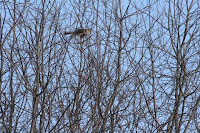
I didn't start out that early but this is what 9:30 AM looked like yesterday morning,
lots of fog! And the fog continued along for most of my hour and a half drive to keep an appointment at 11:30. After my morning visit I had to put in some time before returning for a follow up appointment at 3:30 so I went in search of some water areas, hoping to find some ducks or geese.

I found this beautiful place and in the distance is what I think is an old, no longer used, railroad bridge. I had stopped when seeing some ducks in the water, but before I could get any pictures they had left. I almost left too, but then I heard a loud, constant honking, and finally found its source in the green shadowy area to the left

of the above picture. It was a lone
Canada Goose, and it was difficult to see for the shimmering play of light upon the water gave it a bit of camouflage. If it hadn't been for its loud
'honking' I wouldn't have seen it at all.

Having noted my presence it continued swimming and emerged from the shadows allowing me to see it more clearly.

Returning home again, I encountered darkening skies and more fog during the last half hour of my journey, arriving home in darkness.

 As the white, adult male Northern Harrier scanned the dry, browned, November grasses in search of prey, the dark gray background of the forest enveloped the barren trees in seasonal somberness.
As the white, adult male Northern Harrier scanned the dry, browned, November grasses in search of prey, the dark gray background of the forest enveloped the barren trees in seasonal somberness.















































